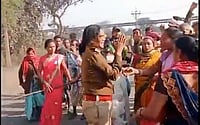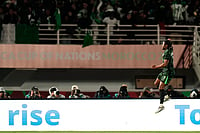Over a period of nine centuries (from the second century BC to the seventh century AD) Buddhist monks and artisans chiseled into the rock, creating 29 caves to serve as their chaityas (prayer halls) and viharas (monasteries). They covered the austere walls of the caves with mural after mural, frieze after frieze, on themes from the life and teachings of Gautama Buddha. And then, suddenly, in what still remains a great mystery they abandoned the caves to the jungle, to the tiger, the deer, and the wild boar. The caves were in a secluded location and were forgotten until, 11 centuries later on April 28, 1819, a British officer hunting wild boar saw the caves and alerted the world to the treasures they contained. It is an amusing thought that if the Wild Life Act had been in force in 1819, the boars would have been safe but the caves might still be waiting to be discovered.
Ajanta is no longer off the beaten path. Hordes of scholars, pilgrims, conservationists, aficionados and tourists climb to the caves every season. The caves, which have survived the ravages of time and the depredations of man face a new danger—the atmospheric strain on the murals from the temperature and humidity fluctuations caused by the crowds. Behl's magnificent book is a call to the duty all of us have to preserve this priceless piece of heritage.
Both style and printing make this book a pleasure to read. It is packed with information on a gamut of subjects, delightfully interspersed with photographs, site plans, line drawings and sketches. The topics include a discussion of Buddhism, a history of the caves, the working methods used in the cave construction, the materials and techniques used in the paintings, the impact of Ajanta on Asian art and notes on the Jataka tales. There is the right balance of text and pictures. Behl's prose is clear, elegant, concise, unpretentious. There is no ecstatic froth and no technical babble.
Anyone who wishes to portray Ajanta either in word or picture will have to be steeped in its very special mystique. Here were monks, sequestered in prayer and meditation, who painted their memories of the world which teemed beyond. They painted sensuous men and women without inhibition. The Buddha had taught them that the world was beautiful but that one should not be seduced by the senses. True bliss comes from detachment and renunciation—a message which comes out in the picture of the great Gautama with his begging bowl at the entrance to his old palace home, a prince no longer, but only a beggar with his wife and son, before him, imploring him to return. The painting, like many others, is very faded and there are large dis-coloured patches but to the discerning eye the story is as poignant as when it was told 2,500 years ago. As Behl says of the ethos of Ajanta, "It is the life of the spirit rather than worldly existence which pervades these paintings." About the painting technique he says, "There are no true shadows but the subtle nuances of shading with almost imperceptible deepening and lightening of the same colour persuade the eye of the roundness of the forms."
The book has 213 illustrations, of which 189 are colour photographs. Bringing out the penumbra of the caves, the architectural details of the chaityas, the chiaroscuro of the columns, the faded grandeur of the pictures poses great photographic challenges. The soft, muted light in Behl's photographs brings out the mystic ambience of the caves and the suffused spirituality of the paintings. We seem to be seeing the paintings in the light by which the monks must have seen them two thousand years ago.
The aficionado is bound to compare Behl's photographs with those in Jean Louis Nou's book Ajanta which came out in 1991 with a text in French by Amina Okada. Inevitably, comparisons will be made of the photo reproductions of the paintings of the Bodhisatva Padmapani of King Dhananjeya and the game of dice, of Buddha and the elephant Nalagiri and of the 'Temptation of the Buddha'. And in sculpture the comparisons will be of the photographic treatment of the Parin-irvana, the Buddha in his final repose with the faithful disciple Ananda grieving at his feet. Such comparisons make us realise why photography is an art and not a mechanical activity and why the camera is an artistic tool and not just an artefact. The same picture, the same sculpture seen through the eyes of two masters can convey different sensations, both equally exquisite. Where Behl's book scores is the comprehensive cave-by-cave photo coverage and the gamut of subjects covered. The succinct narration of selected Jataka stories juxtaposed with full-page colour photo reproductions of the connected Ajanta murals is an easy way for young people to become acquainted with the Buddhist fables as well as the art of Ajanta.


























